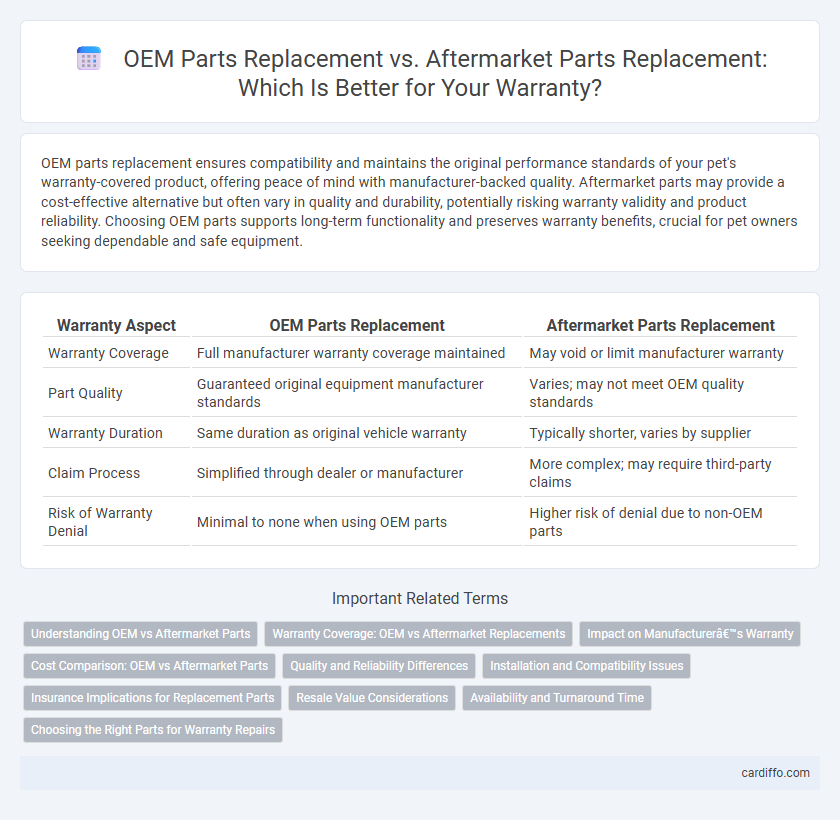OEM parts replacement ensures compatibility and maintains the original performance standards of your pet's warranty-covered product, offering peace of mind with manufacturer-backed quality. Aftermarket parts may provide a cost-effective alternative but often vary in quality and durability, potentially risking warranty validity and product reliability. Choosing OEM parts supports long-term functionality and preserves warranty benefits, crucial for pet owners seeking dependable and safe equipment.
Table of Comparison
| Warranty Aspect | OEM Parts Replacement | Aftermarket Parts Replacement |
|---|---|---|
| Warranty Coverage | Full manufacturer warranty coverage maintained | May void or limit manufacturer warranty |
| Part Quality | Guaranteed original equipment manufacturer standards | Varies; may not meet OEM quality standards |
| Warranty Duration | Same duration as original vehicle warranty | Typically shorter, varies by supplier |
| Claim Process | Simplified through dealer or manufacturer | More complex; may require third-party claims |
| Risk of Warranty Denial | Minimal to none when using OEM parts | Higher risk of denial due to non-OEM parts |
Understanding OEM vs Aftermarket Parts
OEM parts replacement uses components made by the original equipment manufacturer, ensuring perfect fit, compatibility, and warranty compliance for vehicles. Aftermarket parts are produced by third-party companies and may vary in quality, fit, and durability, potentially affecting warranty validity. Choosing OEM parts maintains manufacturer standards and preserves warranty coverage, while aftermarket parts offer cost savings but carry risks of reduced performance and warranty issues.
Warranty Coverage: OEM vs Aftermarket Replacements
Warranty coverage for OEM parts replacement typically guarantees full compliance with the original equipment manufacturer's standards, ensuring repairs meet factory specifications and maintain vehicle integrity. Aftermarket parts replacement warranties often vary by supplier and may offer limited coverage, potentially excluding certain components or conditions compared to OEM policies. Consumers should review warranty terms carefully, as OEM replacements generally provide more comprehensive protection and preserve original warranties while aftermarket parts may risk voiding certain manufacturer guarantees.
Impact on Manufacturer’s Warranty
OEM parts replacement ensures compliance with the manufacturer's warranty terms by maintaining original equipment standards and specifications. Aftermarket parts may lead to warranty denial or voiding if they cause damage or fail to meet the required quality, as manufacturers typically restrict warranty coverage to OEM components. Manufacturers often specify OEM parts in warranty policies to preserve product integrity and safeguard against defects caused by non-original replacements.
Cost Comparison: OEM vs Aftermarket Parts
OEM parts typically cost 20-40% more than aftermarket parts due to original manufacturer specifications and higher quality standards. Aftermarket parts offer a cost-effective alternative but may vary significantly in durability and compatibility, potentially affecting long-term warranty claims. Choosing OEM parts often ensures better warranty coverage, while aftermarket options can reduce immediate expenses but carry a risk of voiding manufacturer warranties.
Quality and Reliability Differences
OEM parts replacement guarantees adherence to original manufacturer specifications, ensuring superior quality and reliability consistent with the vehicle's design. Aftermarket parts may vary widely in quality, often lacking the rigorous testing and certifications that OEM parts undergo, which can lead to decreased performance and potential warranty issues. Choosing OEM parts typically results in better long-term durability and preserves warranty coverage.
Installation and Compatibility Issues
OEM parts replacement ensures precise installation and optimal compatibility as components are designed specifically for the vehicle model, reducing the risk of malfunctions. Aftermarket parts may require additional modifications during installation, potentially leading to improper fit and increased warranty claims due to compatibility issues. Choosing OEM parts minimizes the risk of voided warranties and guarantees adherence to manufacturer specifications for seamless integration.
Insurance Implications for Replacement Parts
OEM parts replacement often ensures full compliance with insurance policy terms, leading to smoother claim approvals and better coverage for repairs. Aftermarket parts replacement may cause disputes with insurers due to perceived lower quality or non-compliance, potentially resulting in denied claims or reduced payout amounts. Insurance providers typically prefer OEM parts to maintain the vehicle's original condition and value, minimizing coverage risks and liability concerns.
Resale Value Considerations
OEM parts replacement ensures the vehicle maintains its original factory standards, which positively impacts resale value by preserving brand integrity and reliability perception. Aftermarket parts, while often less expensive, can raise concerns regarding fit, finish, and long-term durability, potentially lowering a vehicle's resale price. Buyers and appraisers tend to favor vehicles with OEM parts as evidence of proper maintenance and adherence to warranty conditions.
Availability and Turnaround Time
OEM parts replacement ensures high availability and faster turnaround times due to direct supply from manufacturers, reducing downtime for warranty repairs. Aftermarket parts may have variable availability, often leading to longer wait times as these components are sourced from third-party suppliers. Choosing OEM parts streamlines warranty service processes by aligning with manufacturer logistics and inventory systems.
Choosing the Right Parts for Warranty Repairs
Choosing OEM parts for warranty repairs ensures compatibility and maintains the original equipment manufacturer's specifications, reducing the risk of voiding the warranty. Aftermarket parts may offer cost savings but can vary in quality and may not meet warranty requirements, potentially leading to claims denial. Prioritizing OEM parts supports warranty compliance and preserves the vehicle's performance and resale value.
OEM Parts Replacement vs Aftermarket Parts Replacement Infographic

 cardiffo.com
cardiffo.com